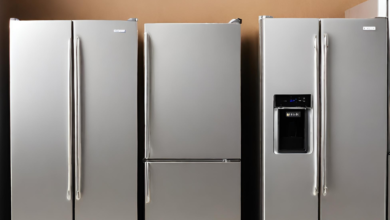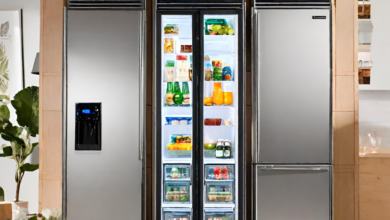Increasing the Longevity of Your Refrigerator with These Tricks

In the modern kitchen, the refrigerator is a silent workhorse, preserving our perishables and ensuring our food stays fresh. As an essential appliance, it’s only natural to want to maximize its lifespan. In this comprehensive guide, we’ll explore a variety of tricks and strategies that go beyond regular maintenance to significantly extend the longevity of your refrigerator.
Understanding the Longevity Factors
Before we dive into the tricks, it’s crucial to understand the factors that contribute to the longevity of refrigerators.
1. Quality Construction
1.1 Robust Materials
The durability of a refrigerator starts with the quality of its construction. Opt for models made with high-quality materials, such as stainless steel, tempered glass shelves, and reinforced plastic. These materials not only enhance the appliance’s lifespan but also contribute to its overall resilience.
1.2 Advanced Components
Look for refrigerators equipped with advanced components, such as inverter compressors. These compressors adjust their speed based on cooling demand, reducing wear and tear compared to traditional compressors. Additionally, dual evaporator systems help maintain optimal humidity levels in different compartments, contributing to prolonged freshness.
2. Optimal Usage Practices
2.1 Temperature Management
Proper temperature management is a fundamental aspect of increasing refrigerator longevity. Set the temperature to the recommended levels – typically around 37°F (3°C) for the fresh food compartment and 0°F (-18°C) for the freezer. Consistent temperatures not only keep food safe but also alleviate strain on the compressor, extending its lifespan.
2.2 Smart Defrosting
Regularly defrosting the freezer is crucial for efficient operation. However, consider utilizing smart defrosting techniques. Instead of relying solely on a predetermined schedule, monitor the frost buildup and defrost the freezer only when necessary. This minimizes unnecessary energy consumption and reduces wear on the defrost system.
Tricks for Prolonging Longevity
3. Strategic Organization
3.1 Temperature Zones
Organize your refrigerator strategically to optimize its efficiency and lifespan. Understand the temperature zones within the appliance – the back and bottom are typically colder, while the door experiences more temperature fluctuations. Store perishable items in the colder zones and reserve the door for condiments and non-perishables.
3.2 Proper Ventilation
Avoid overloading the refrigerator to ensure proper air circulation. An overloaded fridge not only strains the compressor but also obstructs vents, leading to uneven cooling. Maintain space between items to facilitate proper ventilation and reduce the workload on the appliance.
4. Routine Inspection and Preventive Maintenance
4.1 Scheduled Check-ups
Implement a routine inspection schedule to catch potential issues before they escalate. Regularly check door seals, gaskets, and hinges for signs of wear or damage. Inspect the thermostat, defrost system, and fans to ensure proper functionality. Addressing minor issues early on prevents them from affecting the overall durability of the refrigerator.
4.2 Condenser Coil Cleaning
Clean the condenser coils regularly to enhance heat exchange efficiency. Dirty coils can cause the compressor to work harder, leading to increased wear and potentially reducing the appliance’s lifespan. Consult your refrigerator’s manual for specific instructions on accessing and cleaning the condenser coils.
5. DIY Repairs and Upkeep Tricks
5.1 Self-Maintenance Skills
Empower yourself with basic DIY repair skills to address minor issues promptly. Learn to replace a faulty thermostat, door seal, or light bulb. Familiarize yourself with the refrigerator’s manual for troubleshooting tips and step-by-step instructions. Regular self-maintenance can significantly contribute to the appliance’s longevity.
5.2 Lubrication for Moving Parts
Keep moving parts, such as hinges and drawers, well-lubricated. Over time, these components can experience friction, leading to wear and potentially affecting the refrigerator’s performance. Use a food-safe lubricant or the type recommended in your appliance’s manual to ensure smooth operation and prevent unnecessary strain.
6. Energy Efficiency Measures
6.1 Energy Star Certification
Invest in an energy-efficient refrigerator with ENERGY STAR certification. Energy-efficient models are designed to operate with reduced energy consumption, putting less strain on the compressor and other components. Over time, this can contribute to a longer lifespan for your appliance.
6.2 Smart Power Management
Consider utilizing smart power management tools for your refrigerator. Smart plugs with energy monitoring capabilities can provide insights into your appliance’s power consumption. Additionally, some modern refrigerators come with energy-saving modes or features that adjust performance based on usage patterns, contributing to increased longevity.
Advanced Tricks for Enhanced Durability
7. Advanced Temperature Control
7.1 Smart Thermostats
Upgrade to a refrigerator equipped with a smart thermostat. These advanced systems can adapt to your usage patterns, optimizing cooling cycles and reducing unnecessary strain on the compressor. Some models even provide real-time monitoring and the ability to adjust settings remotely for maximum efficiency.
7.2 Temperature and Humidity Sensors
Invest in a refrigerator with temperature and humidity sensors. These sensors provide accurate readings and help the appliance maintain optimal conditions for different types of food. By reducing temperature fluctuations and ensuring proper humidity levels, these features contribute to extended food freshness and increased longevity.
8. Water Filter Replacement
8.1 Regular Replacement
If your refrigerator has a water and ice dispenser, replace the water filter at recommended intervals. A clogged or expired filter can strain the water dispensing system, affecting the overall efficiency of the refrigerator. Regular replacement ensures clean and refreshing water while contributing to the appliance’s durability.
9. Environmentally Controlled Storage
9.1 Ideal Placement
Place your refrigerator in an environment with controlled temperature and humidity levels. Exposure to extreme temperatures or high humidity can strain the appliance’s components and potentially reduce its lifespan. If possible, avoid placing the refrigerator near heat sources or in direct sunlight.
9.2 Climate Control Features
Some advanced refrigerators come with climate control features that adapt to ambient conditions. These features optimize the appliance’s performance based on external factors, ensuring efficient operation in varying environments and contributing to increased longevity.
Conclusion
By incorporating these tricks into your refrigerator maintenance routine, you can significantly enhance the appliance’s longevity and efficiency. From strategic organization and routine inspections to advanced temperature control features, these tips cover a broad spectrum of strategies. Remember that consistent care, informed usage practices, and occasional advanced tricks are key to unlocking the full potential of your refrigerator, ensuring it remains a reliable companion in your kitchen for many years to come.






